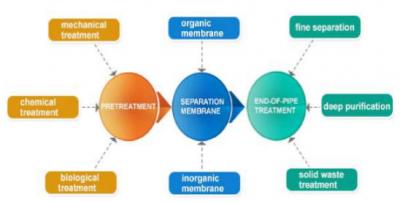Ultrafiltration is basically a pressure-driven membrane process that separates by molecular weight. The pore size of the UF membrane is generally between 1 and 100 nm, and it can cut off substances with a molecular weight of 300 to 500,000 Daltons, including polysaccharides, biomolecules, polymers and colloidal substances. The nominal cut molecular weight of most UF membranes is generally defined as the smallest molecular weight at which the membrane has a rejection of greater than 90%.
Several membrane characteristic parameters that are important in determining the suitability of membranes for separation applications are: porosity, structural morphology, surface properties, mechanical strength, and chemical resistance. These properties depend on the material and fabrication technique of the UF membrane filter. There is a large degree of correlation between these characteristic parameters. For example, only if the polymer material has suitable mechanical strength, the membrane can maintain the structure of high porosity. Resistance to compaction, resistance to chemical cleaning, resistance to bacterial decomposition, resistance to temperature, etc. are all very important for industrial applications of membranes. Membrane surface properties and pore structure morphology have effects on membrane fouling, membrane flux, and solute separation.
The most important performance parameters of membranes are flux (yield) and separation capacity (separation rate of different feed liquid components). Due to the high molecular weight cut-off of UF membranes and the high flux of most UF membranes, the concentration polarization and fouling of UF membranes are more pronounced compared to reverse osmosis systems.
UF technology can remove any of the smallest particles that can be found in water. The particle retention range of ultrafiltration can generally reach 0.001 to 0.01 microns. The particle retention range of microfiltration is 1 to 2 orders of magnitude higher than ultrafiltration, generally 0.1 to 0.2 microns. For general water treatment, including municipal water treatment, the retention range of ultrafiltration is selected in the range of 0.01 to 0.02 microns, which includes the smallest viruses in the water source. Ultrapure water, however, requires an order of magnitude smaller pore size and retention range to ensure complete removal of particulates and sterilization of the filtrate.
Microfiltration can remove viruses to a certain extent because of its depth filtration capability. However, microfiltration is indeed an absolute barrier to bacteria and protozoa parasites such as Cryptosporidium and flagellates, and is therefore also used in municipal water treatment. The separation mechanism of UF technology and MF is different from traditional treatment methods such as particulate and fibrous media filters. Media filtration relies on the principle of gravity removal, and they have a nominal filter pore size larger than the particles to be captured. Particulate media filters may have media particle sizes greater than 100 microns. The absolute rejection range of such a filter is also of the same order of magnitude.




 +86-25-58849045
+86-25-58849045
 +86-25-58749295
+86-25-58749295
 jiuwu@jiuwu.com
jiuwu@jiuwu.com
 No. 9 Park Road, Pukou District, Nanjing City (Sanqiao Factory)
No. 9 Park Road, Pukou District, Nanjing City (Sanqiao Factory) Call us on:
Call us on:  Email Us:
Email Us:  No. 9 Park Road, Pukou District, Nanjing City (Sanqiao Factory)
No. 9 Park Road, Pukou District, Nanjing City (Sanqiao Factory)

 English
English 한국어
한국어 français
français русский
русский Español
Español

